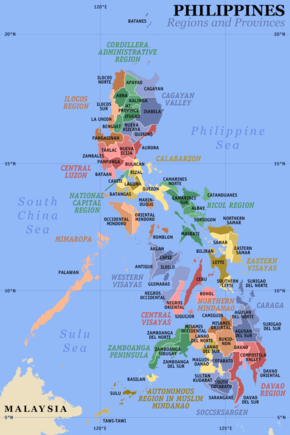Municipalities of the Philippines
| Philippines |
 This article is part of the series: |
|
|
|
Government
Legislature
Executive
Judiciary
Elections
Political parties
Related topics
|
|
Other countries · Atlas |
A municipality (Filipino: "bayan" or "munisipalidad") is a local government unit in the Philippines. Municipalities are also called towns (which is actually a better translation of "bayan"). They are distinct from cities, which are a different category of local government unit (LGU).
Provinces are composed of cities and municipalities. Municipalities, in turn, are composed of barangays or barrios.
Municipalities have some autonomy from the National Government of the Republic of the Philippines under the Local Government Code of 1991. They have been granted corporate personality enabling them to enact local policies and laws, enforce them, and govern their jurisdictions. They can enter into contracts and other transactions through their elected and appointed officials and can tax. They are tasked with enforcing all laws, whether local or national. The National Government assists, supervises and ensures that the local government does not violate national law. Local Governments have their own Executive and Legislative Branches and the check and balance between these two major branches, along with their separation, are more pronounced than that of the national government. The Judicial Branch of the Republic of the Philippines also caters to the needs of local government units. Local governments, such as a municipalities, do not to have their own judicial branch: their Judiciary is the same as that of the national government.
A municipality is headed by a municipal mayor who is the executive officer. The legislature is composed of the vice-mayor (bise-mayor) and eight councilors (kagawad or konsehal). The eight councilors, along with the Sangguniang Kabataan (SK) (Youth Council) President and the Liga ng mga Barangay President, form the Sangguniang Bayan (Municipal Council). All are elected and serve 3-year terms. They cannot serve more than three consecutive terms (9 years).
The Vice-Mayor presides over the legislature, but cannot vote except to break a tie. Laws or ordinances proposed by the legislature (Sangguniang Bayan) may be approved or vetoed by the Mayor. If approved they become law. If the Mayor neither vetoes nor approves the proposal of the Sangguniang Bayan for ten (10) days from the time of receipt, the said proposal becomes law as if it had been signed. If vetoed, the draft is sent back to the Sangguniang Bayan. The latter may 'override' the Mayor by a vote of at least 2/3 of all its members, in which case, the proposal becomes Law.
A municipality, upon reaching a certain requirements-minimum population size, and minimum annual revenue-may opt to become a city. First, a bill must be passed in Congress, then signed into law by the President and then the residents would vote in the succeeding plebiscite to accept or reject cityhood. One benefit in being a city is that the city government gets more budget, but taxes are much higher than in municipalities. As of September 30, 2009 there are 1,514 municipalities.
Contents |
Map
.png)
Income classification
Municipalities are divided into income classes according to their average annual income during the last three calendar years:
| 1st class | P50,000,000 or more. |
|---|---|
| 2nd class | P40,000,000 or more but less than P50,000,000. |
| 3rd class | P30,000,000 or more but less than P40,000,000. |
| 4th class | P20,000,000 or more but less than P30,000,000. |
| 5th class | P10,000,000 or more but less than P20,000,000. |
| 6th class | Below P10,000,000 |
See also
- Sangguniang Bayan
- List of cities and municipalities in the Philippines
hiho jio komngre
External links
|
||||||||
|
|||||||||||||||||||||||||||||
